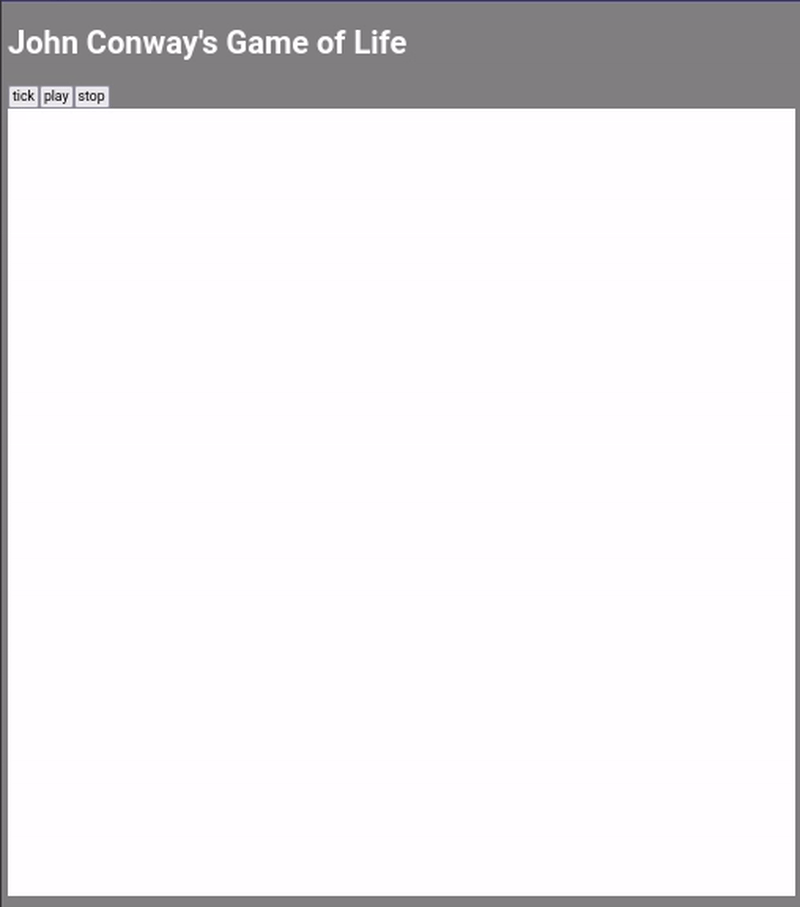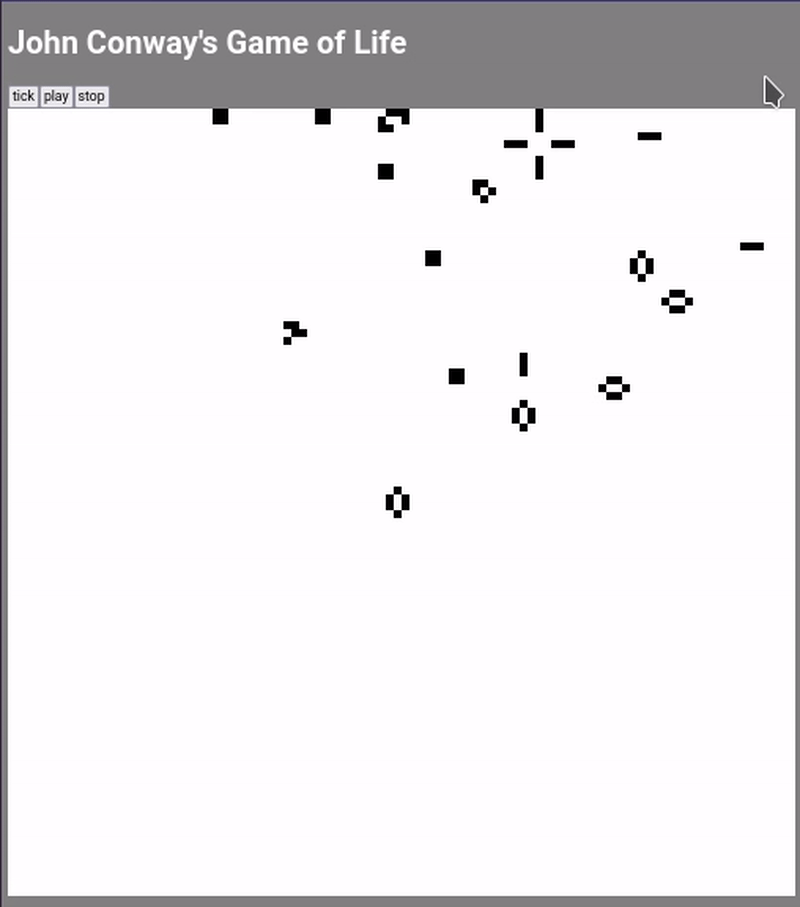Lets build #2 - Conway's game of life
I was wondering what should I make today, and I stumbled upon this little game called “John Conway’s game of life”.
It seemed very interesting and I thought to myself: “How would I build something like this?”
The game
Soo the game is initialy a large grid composed of cells. These cells can eather be dead or alive based on some rules. If they are alive the cell is colored black, when dead it is white.
The rules are as follows:
- If cell has less than two alive neighbours, it dies (as of starvation)
- If cell has three alive neighbours, it becomes alive (as of reproduction)
- If cell gas more than three alice neighbours, it dies (as of overpopulation)
This rather simple rule set can produce a very interesting gameplay as you will see later. This logic set is actually turing complete, so you can essentialy build a computer inside this game. Some people actually built a game of life inside game of life, which is pretty crazy.
The building process
I decided that we are once again just gonna use the plain old java script for this job.
I think that the simplest way of doing this is just to have a large grid of
divs. Each div will represent a cell. When the div has a "cell-on" class, the
cell is alive.
Let’s get going!
Firstly we will grab this html boilerplate and paste it into index.html:
<!DOCTYPE html>
<html lang="en">
<head>
<meta charset="UTF-8" />
<title>John Convay's Game of Life</title>
<meta name="viewport" content="width=device-width,initial-scale=1" />
<meta name="description" content="" />
<link rel="icon" href="favicon.png">
<link rel="stylesheet" href="style.css">
</head>
<body>
<h1>John Conway's Game of Life</h1>
<div class="flex">
<button class="tick-btn">tick</button>
<button class="play-btn">play</button>
<button class="stop-btn">stop</button>
</div>
<section class="game"></section>
<noscript>Please enable java script or use another browser.</noscript>
<script src="app.js"></script>
</body>
</html>Then create the style.css file:
body {
background-color: gray;
color: white;
}
div.cell {
width: 30px;
height: 30px;
background-color: white;
}
div.cell:hover {
background-color: gray;
}
div.cell-on {
background-color: black;
}
.flex {
display: flex;
}
.row {
flex-direction: row;
}
.col {
flex-direction: column;
}This should be good, now onto making the actual cells.
Making the cells work
I imagine a good way of doing this is to have a number of row flex divs, each containing a number of actual cells. This way we have a sort of matrix of divs, each representing one cell.
Create a file named app.js. This will contain all our game logic.
Let’s create some variables that would be usefull for our game:
const COLUMNS = 100;
const ROWS = 100;
// Lets also grab the section where we want to keep our game
/** @type {HTMLElement} */
const gameSection = document.querySelector("section.game");Next step would be adding all the div cells. Here is one way to do it:
for (let i = 0; i < ROWS; ++i) {
const row = document.createElement("div");
row.classList.add("flex");
for (let j = 0; j < COLUMNS; ++j) {
const cell = document.createElement("div");
cell.classList.add("cell");
row.appendChild(cell);
}
gameSection.appendChild(row);
}If you save all the files and open up the index.html file in the browser,
you will notice that we have just a bunch of divs that don’t do much.
Lets allow the user to turn any cell into a living one by clicking on it:
/** @type {HTMLDivElement[]} */
const cells = document.querySelectorAll("div.cell");
for (const cell of cells) {
cell.onclick = () => {
cell.classList.toggle("cell-on");
};
}It should look like this now:

So next step would be to add the actual logic of the rules into our game.
Adding rules
So this is how we are going to do this:
- Make a function called
tickthat contains the rules logic - Go through all the cells and count the number of closest live neighbours
- Mark the cell to die or become alive depending on the number of neighbours
So here it is:
function tick() {
const toDie = [];
const toLive = [];
// Go trough each cell using two loops
for (let i = 0; i < ROWS; ++i) {
for (let j = 0; j < COLUMNS; ++j) {
// Get the cell that we are counting for
const row = gameSection.children.item(i);
const cell = row.children.item(j);
let neighbours = 0;
// Go trough 8 of its neighbours
// This can be done without loops but I found this to be more elegant
for (let x = -1; x < 2; ++x) {
for (let y = -1; y < 2; ++y) {
// I know how ugly the namings are...
const xind = i + x;
const yind = j + y;
// Check if we are out of bounds
if (xind < 0 || yind < 0 || xind >= ROWS || yind >= COLUMNS) {
continue;
}
// Get the neighbouring cell
const ncell = gameSection.children.item(xind).children.item(yind);
// Dont count self as a neighbour
if (cell.isSameNode(ncell)) {
continue;
}
// Up the counter if neighbour is alive
if (ncell.classList.contains("cell-on")) {
++neighbours;
}
}
}
// The actual game logic is simple
if (neighbours < 2 || neighbours > 3) {
toDie.push(cell);
}
if (neighbours === 3) {
toLive.push(cell);
}
}
}
// We alive or kill the cell based on previous rules and that is that
for (const c of toLive) {
c.classList.add("cell-on");
}
for (const c of toDie) {
c.classList.remove("cell-on");
}
}In order for us to be able to see if this is working, lets add a button that
will invoke the tick function on click.
Add this in the body of the index.html
<button class="play-btn">play</button>Add this to the end of the app.js
document.querySelector("button.tick-btn").onclick = tick;This is the result:

Now it is only a matter of making the game play automatically.
Finishing touches
We are going to add two buttons bellow our initial start button:
<button class="play-btn">play</button>
<button class="stop-btn">stop</button>Then in the app.js file we are going to handle the button presses:
// Use this variable for event handle
let playEv = undefined;
// Play button starts the interval
document.querySelector("button.play-btn").onclick = () => {
if (playEv) return;
playEv = setInterval(tick, 100);
};
// Stop button clears the interval
document.querySelector("button.stop-btn").onclick = () => {
clearInterval(playEv);
playEv = undefined;
};The end result
Feels good when you finish a project like this. Play the game on github pages or check out the result below and if you want the full source code, go to the github link.

Comments